Table of contents
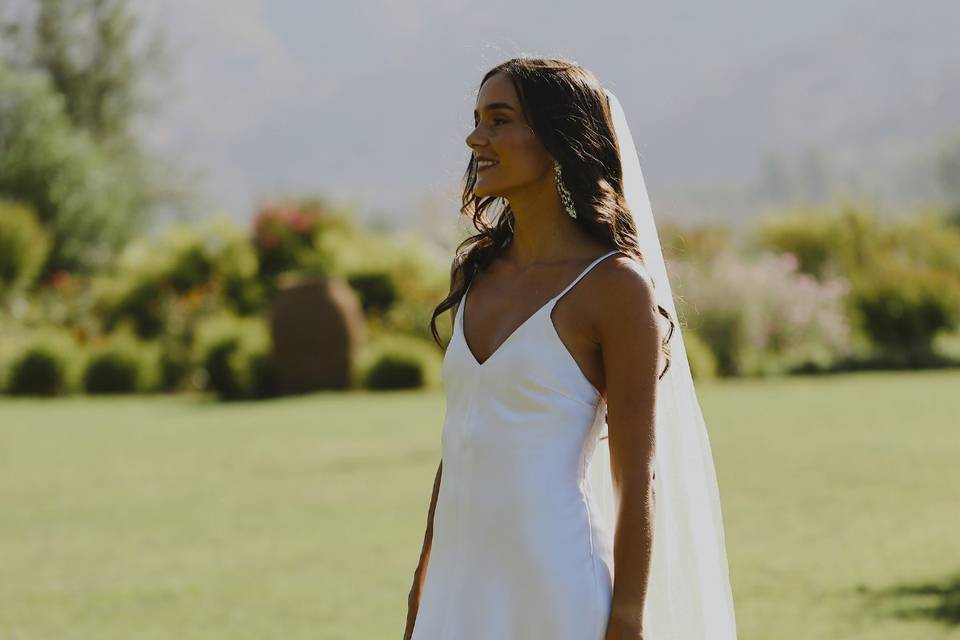 Amelia Brides
Amelia Brides
Once you get engaged and decide to share your life with that other person, the next concern, or rather occupation, will lie in choosing the wedding dress. Do you already know how you want it? Do you imagine it in a particular style? Or, on the contrary, you have no idea where to start looking! Whatever your situation is, in this article you will find absolutely everything you need to know about the wedding dress.You need to know about the wedding dress, from the origin of this piece to the alternatives to the traditional gown.
1. The story about the wedding dress
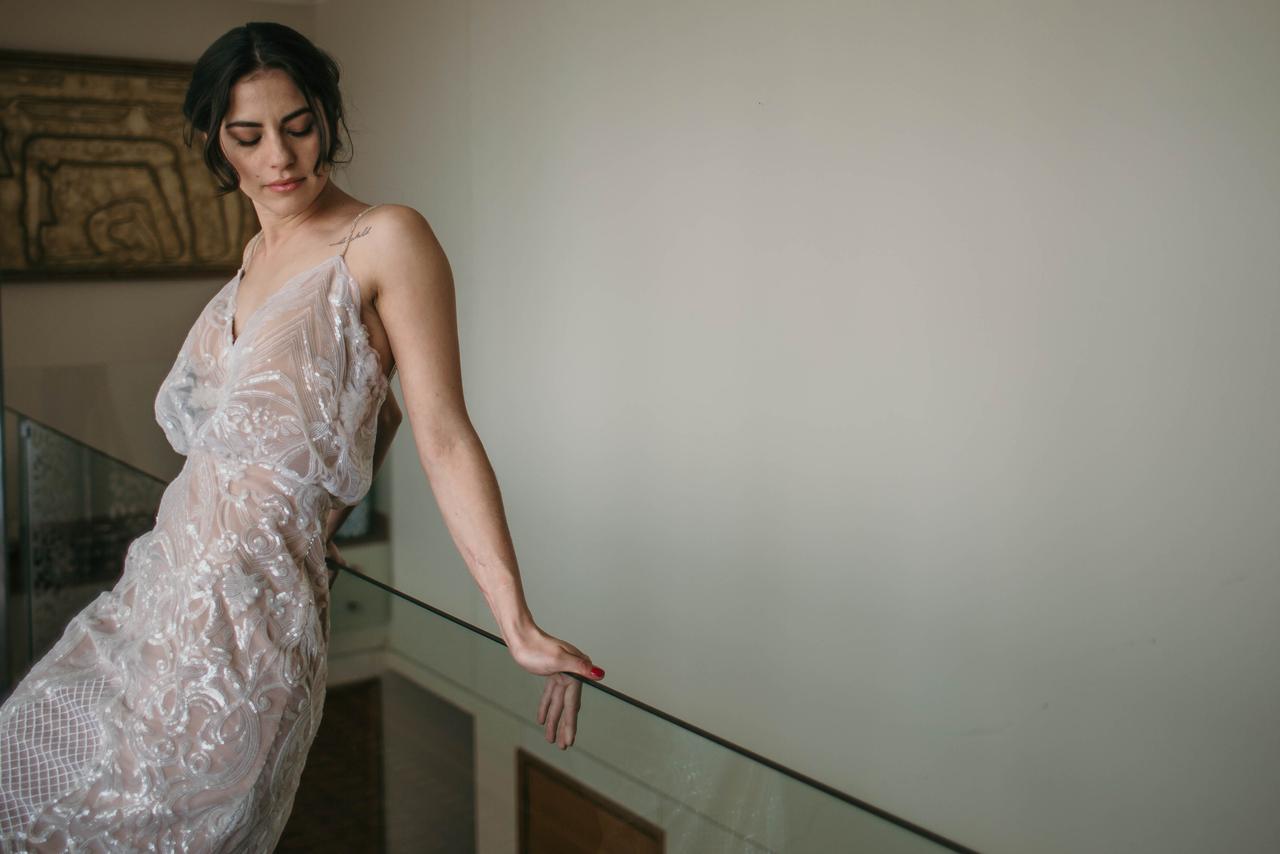 Mary of Bride
Mary of Bride
The wedding dress was not always white, nor as it is known today. The first traces of this garment date back some three thousand years ago, when the Chinese Zhou dynasty imposed that in marriage rites, both bride and groom should wear black robes with red. Later, the Han dynasty introduced the use of colors according to the season in which the celebration took place: green in spring, red in summer, red in winter, and red in winter.In fact, brides in China still get married in a scarlet suit in summer, yellow in autumn and black in winter.
But in the West the story is different, being the Renaissance the starting point of this tradition. And it is that at that time, for the weddings of the nobility, brides wore their best dresses, usually brocade with gold, pearls and jewels, in order to show off their family wealth. Although they were allowed dresses of all colors, with time it was discovered that white represented greater luxury and ostentation. This was due to the technical difficulties involved in bleaching the fabrics and preserving the colour beyond one posture.
And it was Princess Philippa of England who was the first to wear a white tunic, together with a silk cloak, for her marriage to King Eric of Scandinavia, in 1406. But while royal brides began to opt for white, middle-class brides still preferred dark tones to be able to reuse them.
So when was white catapulted as the definitive colour? It was in 1840, when Queen Victoria married Prince Albert of Saxe-Coburg-Gotha, that white became the wedding colour, not least because advances in printing allowed the official photo of the wedding to spread far and wide.
Thus, while the white wedding dress is commonly associated with purity and virginity, the truth is that its origin is linked to economic power and status. Otherwise, it is a garment that has been able to reinvent itself over time and adapt to fashion trends, innovating in cuts, styles and even colors.
But even so, the wedding dress carries with it a series of superstitions and deep-rooted traditions of yesteryear, including the veil, which for the Romans acted as protection against evil spirits. Today it is more aesthetic than anything else.
Or that the groom did not see the bride dressed before the marriage, which dates back to the time when weddings were arranged for economic purposes. Apparently, in order that the man did not regret and undo the agreement, the couple could not see each other until they reached the altar. Currently, the groom seeing the wedding dress before is synonymous with bad luck.
But another of the most popular beliefs, associated with good fortune, is to complement the wedding dress with "something old, something new, something blue and something borrowed", which comes from the rhyme "something old, something new, something borrowed, something blue". It was in Victorian times, in the United Kingdom, that the superstition of wearing these four elements gained strength, which is still practiced in theThe old is associated with roots, the new with the future, the borrowed with brotherhood and the blue with fidelity. Did you know the meanings of these traditions?
2. Step by step to choose a wedding dress
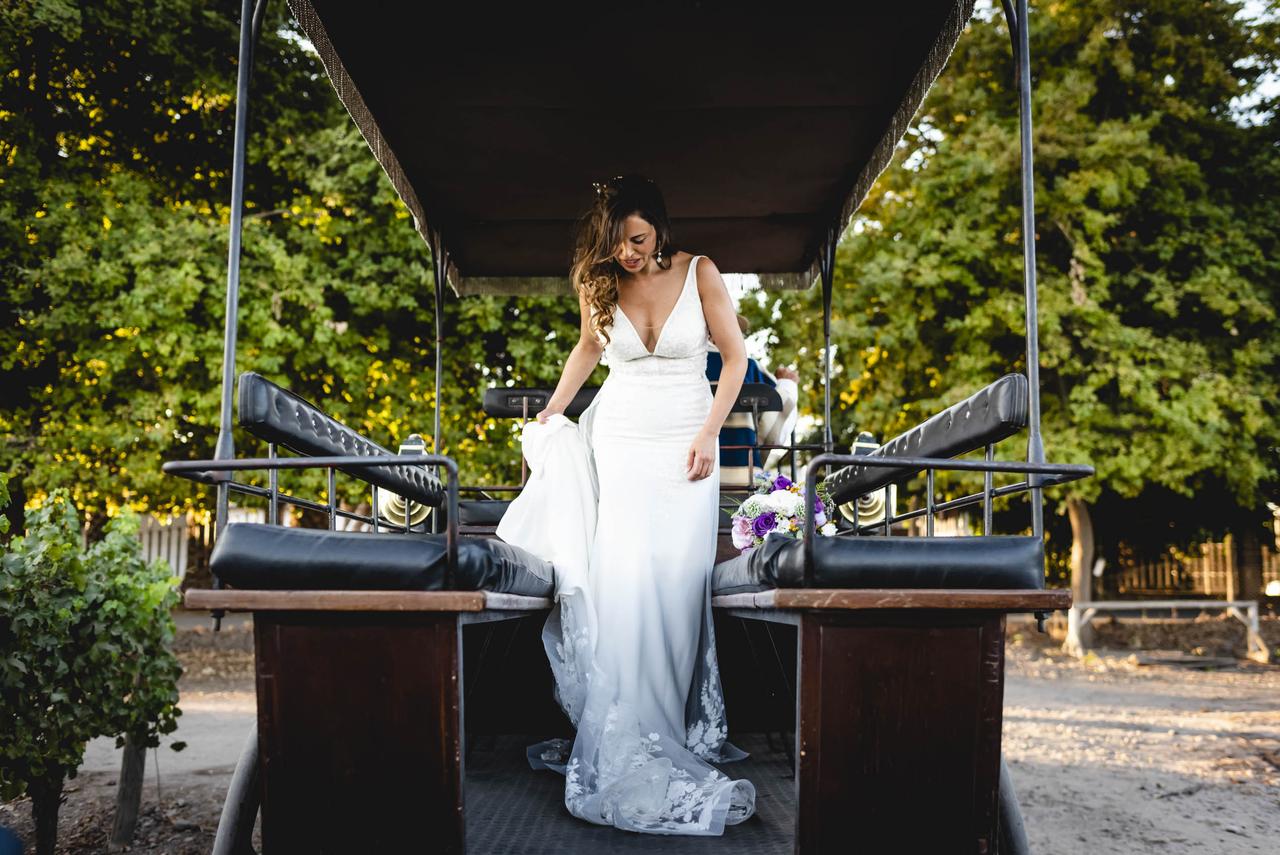 Natalia Oyarzún
Natalia Oyarzún
It is normal to face many doubts when starting the search for the wedding dress And because it has to be "perfect," expectations are high and anxiety is high. The good news is that there are several tips you can take to make it easier on yourself.
The first step, if you don't have it defined yet, is to visualize how you want your wedding to be: urban, beach or country? Simple or glamorous? Day or night? Autumn/winter or spring/summer? These answers will give you the first lights about what you are looking for in a wedding dress.
Then analyze the budget you have available for your wedding dress so you can filter between an international couture gown, a custom design, a national brand dress, a piece purchased on the Internet, a second-hand model or, why not, a rented dress. Having a specific amount will allow you to focus on those viable options, without wasting time in reviewingdesigns that are out of your budget.
Once you have these points clear, start your "showcase", both in online catalogs and physically and take all the time you need. Hence the importance of starting this process with at least six months in advance of the marriage And don't forget that in most stores you'll need to make an appointment, especially now that the pandemic is still raging.
A tip is to find out about the fabrics available, whether they are lighter or heavier. For example, tulle, chiffon, organza, bamboo and lace are optimal for summer, while pique, mikado, ottoman and brocade are ideal for evening weddings. And also familiarize yourself with certain concepts, such as the mermaid silhouette or the bardot neckline.
But don't worry if you don't know which neckline suits you or which cut of dress suits you best if you are short, for example, or according to the style you have in mind, as the stores will advise you on this. Another tip is not to wear make-up, for risk of staining the dresses; to take pictures with the different dresses you try on; to sit, jump and dance with thepiece; and that you are accompanied by a maximum of three people you trust, for example, your mother, your sister and your best friend. Ideally two.
Once you decide on the right wedding dress, resolve all your doubts, from the method of payment, warranties and exchange policies, if you buy it ready to wear, to fittings and laundry service, among other issues.
And for the dress fitting, don't forget to bring the rest of the accessories of your outfit, including shoes, lingerie, jewellery and headdress, so you can evaluate the look as a whole.
Finally, when you get home with your dress, try to store it in a cool, dry place and in the same box it came in at the boutique. Also, avoid handling it, either by trying it on again or showing it to other people.
3. How much does the wedding dress cost?
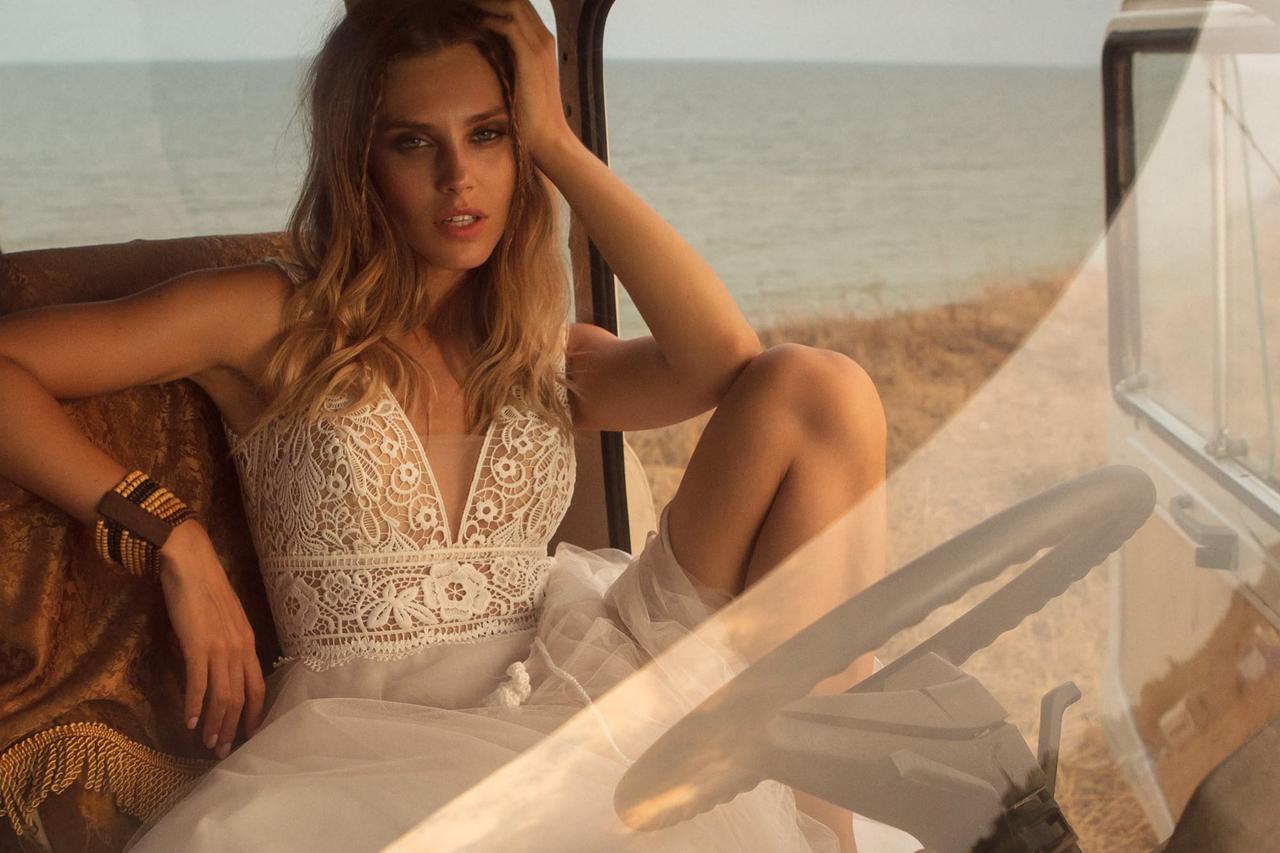 Miami Brides
Miami Brides
Thanks to the increasingly wider offer, the prices of wedding dresses are also more varied. Thus, it is possible to find designs of prestigious international brands, with prices ranging between $900,000 and $2,800,000 approximately. The dress will be more expensive if it is from the new season.
You will also find national brand dresses, marketed in shopping malls or small boutiques, with values ranging between $400,000 and $800,000. Or you can also opt for economic wedding dresses, either imported from China, imitation or second hand, with prices ranging between $80,000 and $250,000.
Now, in case you want a custom design, the value will depend on the fabric, the cut, the complexity of the piece, the season and the dressmaker, designer or atelier you choose, among other factors. The average varies between $500,000 and $1,500,000.
Finally, you can also choose to rent wedding dresses in physical or online stores, with prices that will fluctuate according to the label. A rented dress of an international brand, in most cases, will be more expensive than one of local invoice.
If your plan is not to keep the wedding dress and you also want to save money, you will find designs for rent from $50,000 to $300,000, if you are looking for a well-known brand.
4. Types of wedding dresses
Cuts
 Maria and Leonor Brides
Maria and Leonor Brides
When starting the search for the suit, it is advisable to identify the main cuts of wedding dresses One of them is the princess cut, which is characterized by having the waistline adjusted to the waist, from where a skirt of great volume emerges. This cut is ideal for classic or romantic wedding dresses.
A-line dresses, meanwhile, are fitted to the waist, then flow into an inverted triangle-shaped skirt. It is very suitable for casual dresses, such as boho-inspired dresses.
Another popular cut in wedding dresses is the mermaid silhouette, whose waist is tight to mid-thigh or knees, from where it opens taking the form of a fishtail. The mermaid cut is perfect for setting elegant, sensual and minimalist designs, among other options.
The empire cut, on the other hand, is distinguished by a waistline that cuts just below the bust, to then start the fall of the skirt that can be straight, wide or flared, as desired. The empire cut dresses provide a Hellenic air, while they are great for pregnant brides. In fact, they stand out among the favorites when it comes to tracking wedding dresses for chubby,although everything will depend on the design and tastes of the bride.
Then, the flared cut is one that is tight at the top and whose skirt marks the waist, but not the hips, and can be more or less voluminous. The flared cut is timeless and adapts to different styles.
While the straight cut implies a pattern that, although it frames the figure, it does not stick to the body, giving an extra comfort. The straight cut is a good option, for example, for blousy wedding dresses.
Finally, the midi cut does not refer to the fall of the skirt, but to the length of the piece. This type of dress, very popular among today's brides, is characterized by cutting mid-calf, either a little higher or lower, offering loose, straight or tight skirts.
Thus, you can choose between long dresses, midi dresses and short wedding dresses, the latter, which are usually at knee height or slightly above it, being ideal for civil ceremonies or more informal weddings, for example on the beach.
But there are also asymmetrical wedding dresses, such as the so-called mullet or high-low, which are those long at the back and shorter at the front. Unbeatable for those who do not decide on a single length.
Necklines

For all tastes and different silhouettes, there are different necklines that accompany wedding dresses, so identifying them is a great help when looking for the perfect outfit. And far from being a detail, the neckline will be the protagonist of your bridal outfit.
If you like strapless, you will be able to choose between the strapless and the heart. The strapless neckline is straight and has no sleeves or straps, making it ideal to wear with a jewel. It is classic and timeless. The sweetheart neckline, meanwhile, stands out among the most romantic, as it outlines the bust precisely in the shape of a heart. Besides being sweet, it gives a subtle touch of sensuality.
For its part, the traditional V-neckline But there is also a more pronounced version, called deep-plunge neckline, in which the V-cut is quite deep and can even reach the waist.
In more discreet necklines you will find the boat or bateau, elegant and sober, drawing a slightly curved line that goes from shoulder to shoulder, at the level of the collarbones.
The halter neckline This neckline, which stands out among the most sophisticated ones, is fastened at the back of the neck, leaving shoulders, arms and generally also the back uncovered. This neckline can be closed or open in V at the front.
While the swan neckline is high and covers the whole or half of the neck, with or without sleeves, which invites to wear an updo.
On the other hand, the round neckline is characterized by a rounded curve perpendicular to the neck, either more open or closed.
And the square neckline, also called French neckline It is distinguished by cutting in a straight line over the bust and rising in a vertical line towards the shoulders covered by straps or sleeves.
Feminine and flirtatious, on the other hand, it is the bardot neckline or off-the-shoulder neckline so called because it leaves the shoulders uncovered, adorning the arms by falling straps, sleeves or ruffles.
But if you are looking for a delicate neckline with a touch of magic, none will be more accurate than the one of illusion It is a neckline, usually a sweetheart, strapless or sweetheart/deep plunging neckline, which is covered with a fine fabric called illusion net, and this illusion net can be made of semi-transparent tulle, embroidered organza or tattoo effect lace, among other options.
Meanwhile, the Queen Anne closes behind the neck, leaving the neckline uncovered and covering the shoulders as if it were two thick straps.
Finally, the asymmetrical neckline is the one that shows an open shoulder, standing out as an excellent option for modern brides or those who are looking for a Greek goddess look. Because of its multiple possibilities, the asymmetric neckline is chic and avant-garde.
Sleeves
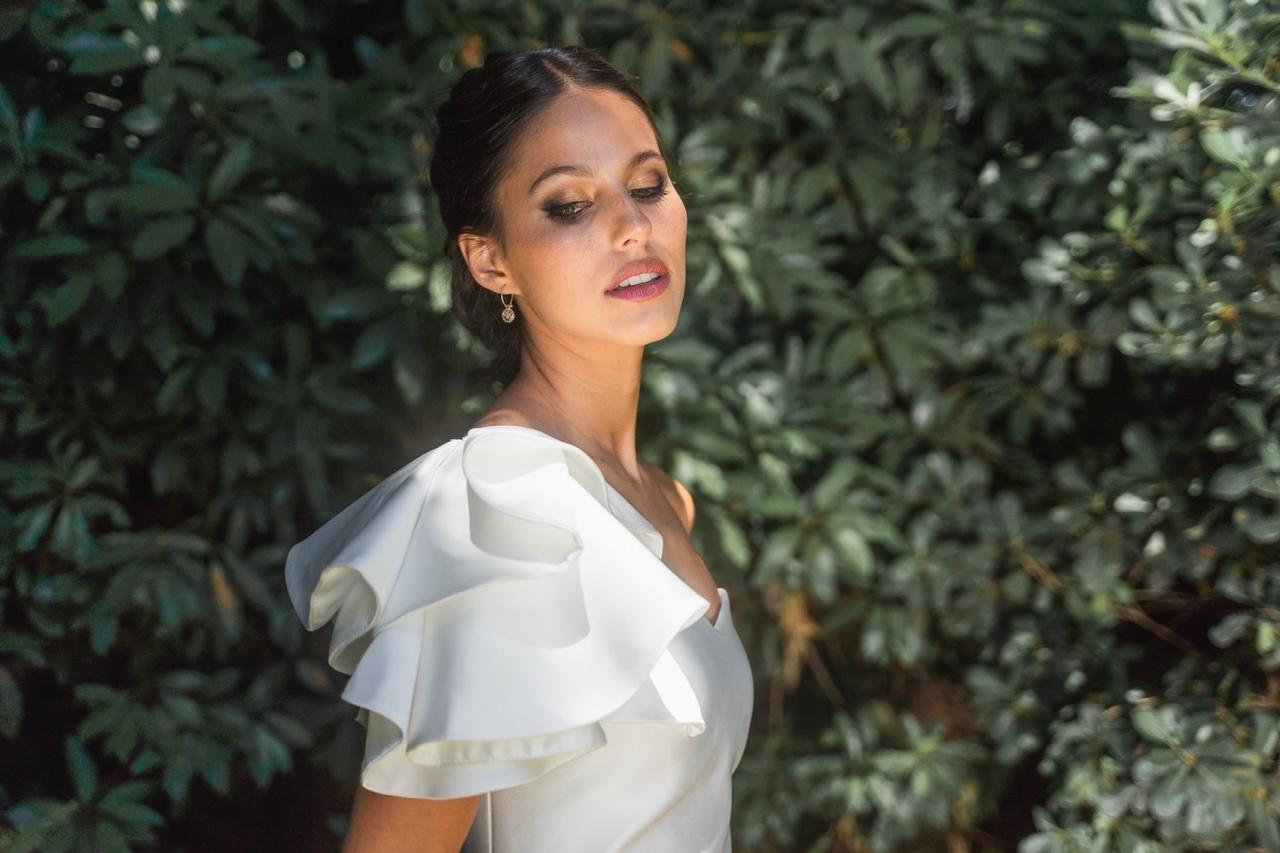 The Fly Photo
The Fly Photo
Regardless of the season or the style of dress you choose, sleeves will always be an attention grabber. And while you may know them all, you probably don't associate some of them with the right name.
In addition to wedding dresses with traditional long sleeves and short sleeves, there are also French or three-quarter sleeves, which are cut between the elbow and the wrist. They are stylish and a very versatile option,
But when it comes to types of sleeves for wedding dresses, there are at least ten that are frequently seen among wedding dresses:
- The cap sleeves They are short, rounded and cover only the shoulder and upper arm. They are discreet and elegant.
- The armhole sleeves The shoulder straps, barely larger than suspenders, wrap around the shoulder all the way to the end, but do not reach the arm.
- The butterfly sleeves Short, youthful and light, they start tight at the armhole, and then gradually acquire volume in a flared shape.
- The tulip sleeves They are cut in two segments, resembling the petals of the tulip flower, and usually come down slightly from the shoulder.
- The bell sleeves The long sleeves, ideal for hippie chic or boho dresses, start narrow from the shoulder and widen progressively, more intensely from the elbow. They can be French or long.
- The poet sleeves for vintage-inspired outfits, which are loose-fitting, but tighten at the cuffs.
- The bat sleeves The arms, whether medium or long, wrap around the arms as part of the torso of the dress, emulating the wings of this mammal.
- The dropped sleeves They can be of different types (sleeves, with ruffles), with the only condition that they do not cover the shoulders.
- The Juliet sleeves The neckline of the dress is made up of a puffed collar between the shoulder and the elbow, and then it is tightened to the rest of the arm, up to the wrist.
- And the balloon sleeves The short version is puffed at the shoulders and fastened at the biceps, while the short version has a narrower cuff between the elbow and the wrist. Nowadays, it is common to see wedding dresses with detachable balloon sleeves.
In fact, dresses with removable pieces are on trend and, among them, sleeves appear as the favorite element. But not only puffed sleeves can be mounted to a wedding dress, but also flared sleeves or dropped sleeves, among other options.
Fabrics
 Miami Brides
Miami Brides
Do you know how to distinguish between organza and chiffon? Or between mikado and ottoman? Since there are many fabrics that appear in bridal fashion catalogs, here we differentiate them to facilitate your search.
- Gauze It is a fine and light fabric, made of cotton, silk or wool yarns, characterized by its fluid movement and low density, making it ideal for flowing and ethereal wedding dresses.
- Tulle Tulle: It is a net-like fabric, light and transparent, made with multifilament yarn, either natural fibers such as silk, artificial fibers such as rayon or synthetic fibers such as nylon. With a rough texture and mesh-like appearance, tulle is widely used in romantic dresses.
- Organza Organza is a light silk or cotton textile, distinguished by its rigid, yet semi-transparent façade. With a starched appearance, organza can be found in an opaque or satin finish. It is ideal for creating skirts with ruffles.
- Bambula Bambula is a very light fabric made of cotton, silk or synthetic fibre, whose manufacturing system produces permanent creases or a wrinkled effect that does not require ironing. Bambula is very suitable for loose-fitting dresses, whether boho, vintage or Grecian style.
- Georgette A fine, light and elastic fabric, slightly translucent, made from natural silk, it is an ideal fabric for flowing dresses with a lot of movement, for example, with A-line skirts.
- Charmeause Charmeuse is a very soft and light textile, based on silk or polyester thread, woven in satin. The Charmeuse has a shiny front and an opaque back, ideal for dresses with a touch of glamour.
- Crepe Plain fabric, which can be made of wool, silk, cotton or polyester, with a grainy appearance and slightly rough surface, with a matte finish. Crepe fits well to the skin, making it perfect for mermaid silhouette designs and elegant wedding dresses in general.
- Gazar : This is a fine natural silk fabric, uniform, with regular weft and warp, with a good body and grainy texture. Among its attributes is that it is ideal for maintaining the shape of, for example, a flared midi skirt.
- Lace It is a fabric made of silk, cotton, linen or metallic threads, twisted or braided, which is also used applied on other fabrics. There are different types of lace such as Chantilly, Schiffli, Guipur or Venice lace, which vary according to the way the fabric is worked. If it is not all over the dress, the lace is usually seen on the bodice and sleeves.
- Piqué Piqué : A cotton or silk fabric with a raised texture, usually in the form of a mesh, diamond or honeycomb. Slightly rough and starched in appearance, piqué is ideal for classic and voluminous wedding dresses.
- Dupion Silk fabric with imperfect spinning, which results in a grainy and irregular surface. It is a medium weight fabric with great body, texture and lustre.
- Mikado: Made from thick natural silk, mikado is full-bodied and has a slightly grainy texture and, due to its stiffness, it enhances lines very well while offering a lustrous finish. It is great for classic princess-cut dresses, for example.
- Otoman thick fabric of silk, cotton or worsted yarn, whose corded texture, in the horizontal direction, is produced because the warp threads are much thicker than those of the weft. It is strong and full-bodied, suitable for winter bridal gowns.
- Satin With a shiny surface and a matte back, it corresponds to an elegant, soft, smooth to the touch and full-bodied fabric made of cotton, rayon or polyester, very popular for lingerie wedding dresses.
- Taffeta This fabric is formed by the crossing of threads, which gives it a grainy appearance. It is usually made of silk, although it can also be made of wool, cotton or polyester. It is a soft fabric, but slightly stiff and shiny in appearance. Very effective for creating draperies.
- Satin Satin is a lustrous silk fabric, shiny on one side and matte on the other. Soft, uniform, smooth and consistent, satin gives a majestic touch to the wedding dresses it covers.
- Brocade Finally, brocade is defined as a silk fabric interwoven with metal or shinier silk threads, which gives rise to its embossed motifs, whether flowers, geometric figures or other briscate designs. It is a thick, dense, medium-weight fabric; while it is soft and velvety to the touch.
Although these are the most common fabrics in wedding dresses, especially tulle, lace, crepe and mikado, we can't forget the printed designs either. And among them, the most popular are dresses dotted with flowers in pastel colours, ideal for a romantic wedding or designs with botanical prints, for rustic-inspired brides. Whether or not they are in 3D.
The prints can cover the entire piece or be positioned in specific areas, such as the neckline cascading down to the skirt. And although they are less common, it is also possible to find wedding dresses with subtle polka dot print, or veils with this print. But if it comes to glamor, another trend in wedding dresses, which is gaining more and more ground, are the designsshiny, either lace with sequins or tulle with glitter, among other fabrics.
Styles
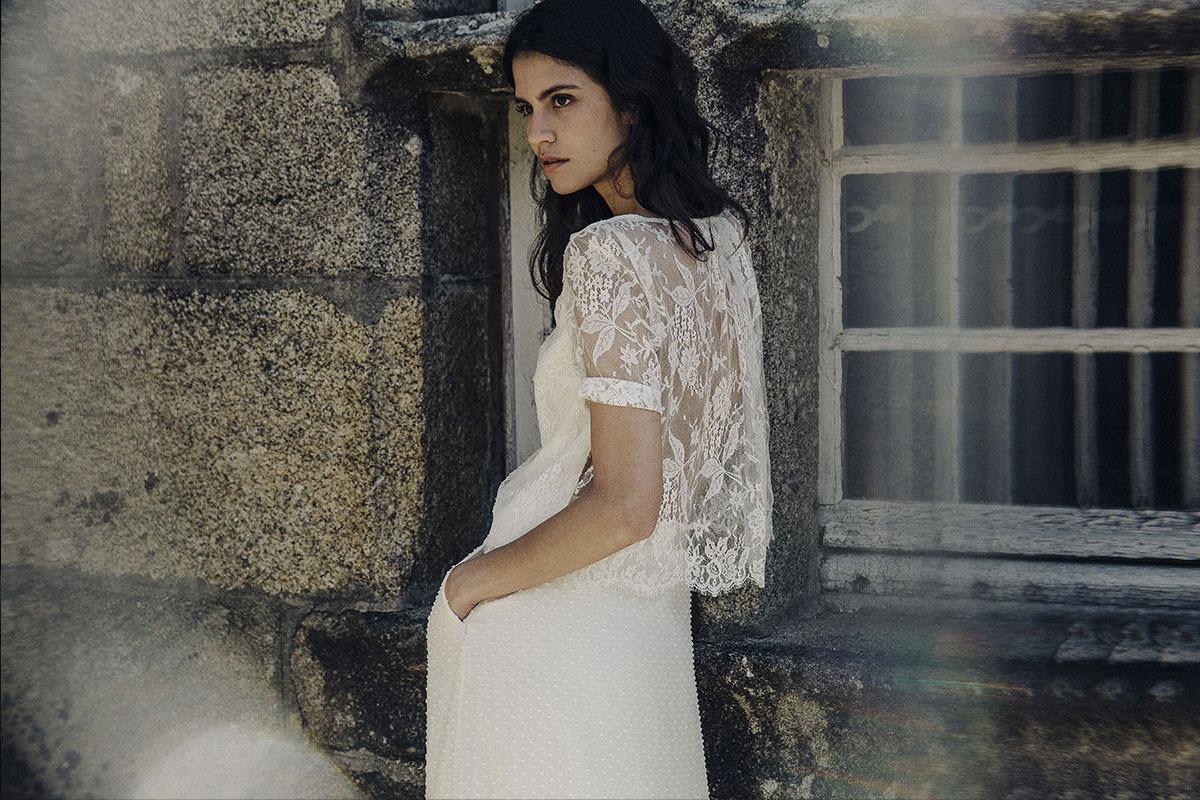 Yenny Brides
Yenny Brides
Since there are many styles of wedding dresses It's normal to get confused when you start looking for your outfit, so it's important to be clear about the type of wedding you want to celebrate, the season and the time of the day. Get inspired with these ideas.
- Classic wedding dresses If you are looking for a classic design, you will love the princess cut wedding dresses, made in rigid fabrics such as mikado. The boat neckline, for example, is ideal to complement dresses with majestic skirts, as it is elegant and discreet.
- Romantic wedding dresses Tulle and lace are the fabrics of choice for brides with a romantic inspiration, while sweetheart and illusion necklines are the most popular. If you long for a fairytale gown, choose a princess cut gown with a flowing tulle layered skirt, complemented by a delicate lace bodice with beading or tattoo effect embroidery.
- Vintage wedding dresses: Recapturing elements of the past is the motto of vintage dresses, so you'll find designs with midi skirts, long puffed sleeves, high collars, buttoned backs, dense lace, fringed finishes and even dresses in "aged" tones, such as off-white or vanilla.
- Hippie chic wedding dresses Generally A-line, empire or flared, hippie chic or bohemian wedding dresses are fresh, flowing and made in fabrics such as bamboo, chiffon, macramé or tulle plumeti. Most are distinguished by their pleated skirts, flared sleeves, French sleeves, bodies with geometric patterns, off-the-shoulder necklines with ruffled or flouncy bodies. Get inspired by these 100hippie chic wedding dresses!
- Minimalist wedding dresses Simple wedding dresses, characterized by their clean lines and plain fabrics, will be trendy this 2022 and you will find many options, from a sophisticated mermaid silhouette dress in crepe, without any embellishment, to a satin lingerie style design with thin straps. Otherwise, if you choose a minimal design, you can play more with your accessories.
- Sensual wedding dresses: On the other hand, if you want to enhance your curves, show off your physical attributes or simply give a sensual touch to your wardrobe, there are several elements from which you can choose, for example, opt for dresses made of semi-transparent fabrics, with corset bodies, skirts with pronounced slits, side panels at the waist, deep plunging necklines, and so on. e or open backs.
- Glamorous wedding dresses Shiny fabrics, rhinestones and intricate crystals, among other details, will give the glamorous touch to the wedding dress of your dreams. Therefore, if this is what you want to make an impact at your wedding, go for gowns with shimmering finishes, or dresses with impressive skirts or tails that drag for several meters, whether princess or mermaid silhouette.
- Autumn/winter wedding dresses: Choose a dense fabric, such as ottoman, pique or brocade, and go for a beautiful dress with long sleeves, a closed neckline, such as round or swan, and complement the look with a glamorous cape. Or even if you're getting married in the rainy season, you can opt for a hooded cape or a furry jacket. You'll look great!
- Spring/summer wedding dresses Short wedding dresses: In addition to choosing a long model in a light fabric, such as chiffon or tulle, short wedding dresses are a great option for the good weather seasons. From elegant straight knee-length designs, for example in taffeta (little white dress type), to more playful models with tutu-style tulle skirts. And watch out that if you like shoes, a short dress will be the best garment forto show them off.
- Wedding dresses for the civil wedding: Since civil ceremonies allow more freedom and are not so much governed by protocol, colored wedding dresses will be a good choice to get out of the traditional. For example, opt for a discreet model in pale pink, ivory, cream or nude. The latter, which is still very trendy these days. Now, if you are an alternative or rocker bride, a black wedding dress will also be a good choice.Although they are in the minority, you will still find in the new catalogs black wedding dresses or with details in this color, for example, in a bow or belt. Check this list with 130 wedding dresses for the civil wedding!
- Modern wedding dresses: Finally, if you are not convinced by a modern wedding dress, there are other alternatives that you can take. From a two-piece suit composed of a pleated skirt and crop top, hippie chic trend, to pants with blouses, if you prefer something more formal. But there are also the jumpsuits, which are composed of pants and body one piece, possible to find atThey are comfortable, practical and very versatile. Now, if you prefer a more masculine outfit, you will love the tuxedos for brides. It is an outfit made up of a pair of skinny or straight trousers, together with a tailored jacket, under which you can wear a shirt or top. You will surprise with this sophisticated and modern outfit.
You already know! Regardless of your style, the bridal fashion catalogues are packed this 2022, so you're sure to find a design that fits exactly what you're looking for. From simple, boho-inspired wedding dresses to urban, glitzy styles, it's up to you to decide how you want to look on your special day!
We help you find the dress of your dreams Request information and prices of dresses and accessories from companies near you Request information
